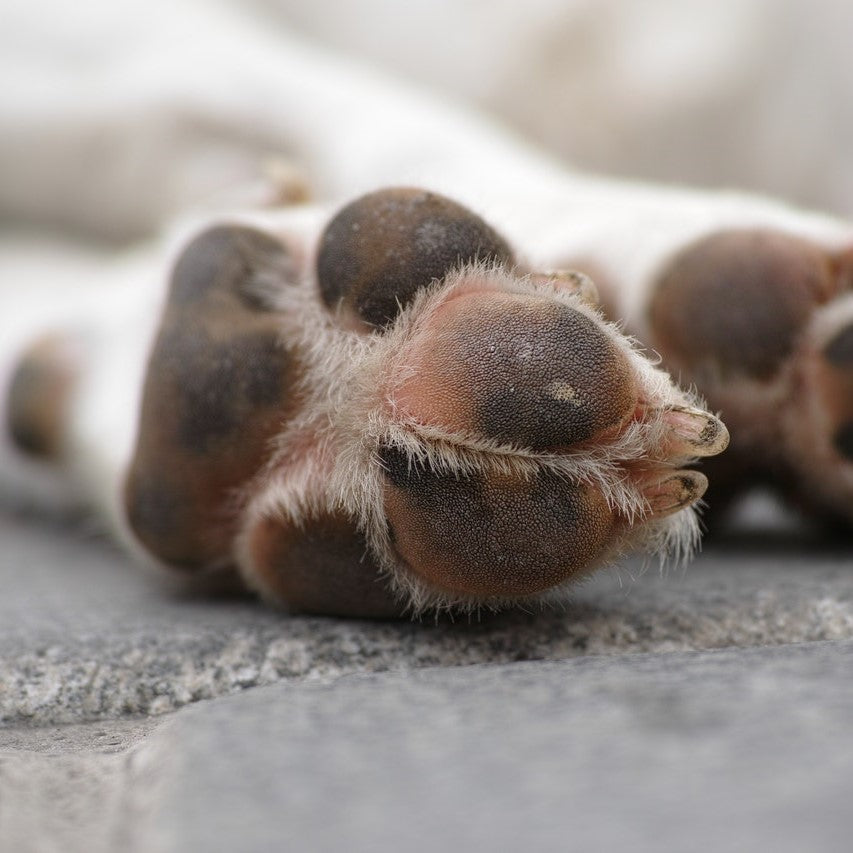
Everything You Never Knew About Dog Paws
Let’s Talk Dog Paws
Quite possibly the hardest-working part of your dog’s body
As a quick guide, your dog is a digitigrade, meaning they walk on their toes rather than the flat of their whole foot as we do. Most dogs have five toes on their front paws and four on the back. The dew claw on the front paw is technically a toe. Some breeds, notably herding dogs, have five toes front and back, while the Norwegian Lundehund boasts a remarkable six toes on each foot, thought to assist with climbing rocky crags. A few breeds even have webbed paws to aid in swimming.
Toes and Pads
Each toe has a paw pad, and the larger pad below the toes is called the metacarpal pad. All the pads act as shock absorbers, protect the foot, and provide grip. They also help with cooling to a degree, as your dog’s only sweat glands are located in their paw pads.
The rough texture of the pads aids traction, while the skin on your dog’s paws is highly specialised. Interestingly, it cannot be repaired by skin transplants from other parts of their body.
Claws
What about dew claws? They might seem like useless appendages, but if you watch your dog gripping a bone or toy, you’ll see they help with light gripping. Although they move a lot, most dew claws are attached to the bone and can offer some use, such as when turning at high speeds. However, in some cases, they’re only attached by a flap of skin, making their function less clear.
In certain situations, dew claws can become problematic. I used to have a collie who regularly ripped hers, so we decided to have them removed. However, in general, they should be left alone.
Most dogs have dew claws on their front legs but not the back. That said, some dogs do have rear dew claws, and a few breeds even have double dew claws. For certain herding breeds, double rear dew claws are part of the breed standard, as they help navigate rocky terrain.
Focusing on the fleshy digital and metacarpal pads, these are unique structures containing special fatty tissue that is more resistant to freezing than other tissue. The skin on the paws is far thicker than anywhere else on a dog’s body, but this doesn’t make it indestructible.
Each toe also has a claw, which is directly attached to the bone. Like human nails, claws grow throughout a dog’s life and often require trimming, especially if your dog doesn’t do much road walking. Many owners opt to have a groomer or vet nurse take care of this. Dew claws are particularly important to monitor, especially in longer-coated breeds, as they can grow unnoticed and curl into the pad, causing pain and infection.
Paw Problems
Hard-Wearing but Not Indestructible
While your dog’s paws are built to withstand a lot, they’re not invincible. Hot pavements can cause blistering, and rock salt or de-icing chemicals can lead to sores and infections.
Itchy Paws
Itchy paws are a common issue, particularly in spring and summer. Stinging nettle shoots and other irritants can contribute, as can seasonal allergies. This discomfort often causes dogs to chew their paws, leading to soreness and a cycle of irritation.
Yeast Issues
Dogs with yeast problems in their paws often have a telltale "popcorn" smell. Yeast can cause itching, leading to nibbling and chewing, which worsens the issue.
Grass Seeds
Grass seeds are a summer menace. Small but dangerous, they can work their way into the paw and travel up the leg, causing significant pain and infection. Regular checks and keeping paw pads free of fur can help reduce the risk. Groomers often trim paw pads as part of their service, and this is something to keep in mind if you groom your dog at home.
Sea Swimmers and Soft Pads
Dogs that swim in the sea frequently or don’t walk on roads often have softer pads, making them more susceptible to abrasions, cracks, and sores. Regular checks are essential.
Split Paw Pad Disease
This condition is something I hadn’t encountered until Toby’s owner over at @tobyandskye on Instagram reached out to me. Toby, a black lab, had been diagnosed with split paw pad disease, a painful condition where the surface of the pad breaks down, turns white and mushy, then peels off to reveal redness underneath.
There’s little information available on the cause or treatment, and sadly, while my Herbal Salve offered some relief, it wasn’t the magic cure I’d hoped for. This seems to be a condition requiring prevention rather than treatment during flare ups. If anyone has experience with this, I’d love to hear more, as it’s an area that needs more understanding.
Caring for Your Dog’s Paws
Keeping an eye on your dog’s paws regularly is invaluable, especially after walks on rough terrain.
An application of paw balm can help keep pads moisturised and soothe cracks or damage. Paw balm is perfect for dry, crusty noses and elbow calluses too. Handmade from natural butters and oils, it also contains hemp oil, which is rich in Omega 3 and 6, essential for skin health.
Using balm regularly is also a great opportunity to check for any issues, like cuts or debris stuck in the pads.
Lastly, keeping nails trimmed and paw pads free of fur will help minimise the risk of foreign objects getting embedded and improve traction for your dog. It also aids cooling, allowing the sweat glands to function properly.